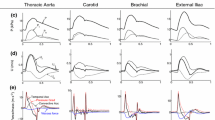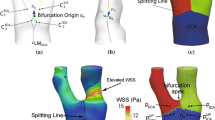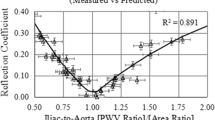Abstract
In order to investigate the contribution of arterial radius and center-line velocity to the blood conductivity and electrical impedance of pulsatile flow in the human common carotid artery, we proposed three simplified mathematical models to describe the relationship between the center-line velocity, the arterial radius, and the blood conductivity. By comparing the fitting results with those obtained from our previously proposed elastic-tube hemodynamic model, we found that the change in center-line velocity had more notable effect on the blood conductivity than the change in arterial radius. Moreover, the change in arterial radius contributed much more to the electrical impedance than the change in blood conductivity induced by the center-line velocity.

ᅟ





Similar content being viewed by others
References
Manbachi A, Hoi Y, Wasserman BA, Lakatta EG, Steinman DA (2011) On the shape of the common carotid artery, with implications for blood velocity profiles. Physiol Meas 32(12):1885–1897
Yacoub M, Elguindy A, Afifi A, Yacoub L, Wright G (2014) Taking cardiac surgery to the people. J Cardiovasc Transl Res 7(9):797–802
Apfel H (1990) Electrical impedance of the carotid artery in response to various types of stress. In: Biofluid Mechanics Blood Flow in Large Vessels. Springer-Verlag, Berlin Heidelberg, pp 193–200
Tomsin K, Mesens T, Molenberghs G, Gyselaers W (2011) Diurnal and position-induced variability of impedance cardiography measurements in healthy subjects. Clin Physiol Funct Imaging 31(2):145–150
Bernstein DP, Henry IC, Banet MJ, Dittrich T (2012) Stroke volume obtained by electrical interrogation of the brachial artery: transbrachial electrical bioimpedance velocimetry. Physiol Meas 33(4):629–649
Ebrahim M, Hegde S, Printz B, Abcede M, Proudfoot JA, Davis C (2016) Evaluation of impedance cardiography for measurement of stroke volume in congenital heart disease. Pediatr Cardiol 37(8):1–5
Gaw RL, Cornish BH, Thomas BJ (2007) Comparison of a theoretical impedance model with experimental measurements of pulsatile blood flow. Proceedings 13th International Conference on Electrical Bio-impedance and the 8th Conference on Electrical Impedance Tomography ICEBI 2007(17): 32–35
Gaw RL, Cornish BH, Thomas BJ (2008) The electrical impedance of pulsatile blood flowing through rigid tubes: a theoretical investigation. IEEE Trans Biomed Eng 55(2):721–727
Kubicek WG, Karnegis JN, Patterson RP, Witsoe DA, Mattson RH (1966) Development and evaluation of an impedance cardiac output system. Aerosp Med 37(12):1208–1212
Peura RA, Penney BC, Arcuri J, Jr AF, Wheeler HB (1978) Influence of erythrocyte velocity on impedance plethysmographic measurements. Med Biol Eng Comput 16(2):147–154
Raaijmakers E, Marcus JT, Goovaerts HG, De Vries PMJM, Faes TJC, Heethaar RM (1996) The influence of pulsatile flow on blood resistivity in impedance cardiograp. 18th Annual International Conference of the IEEE Engineering in Medicine and Biology Society, 1957–1958
Sakamoto K, Kanai H (1995) Electrical characteristics of flowing blood. IEEE Trans Biomed Eng BME-26(12):686–695
Shankar TMR, Webster JG, Shao SY (1985) The contribution of vessel volume change and blood resistivity change to the electrical impedance pulse. IEEE Trans Biomed Eng 32(3):192–198
Kosicki J, Chen LH, Hobbie R, Patterson R, Ackerman E (1986) Contributions to the impedance cardiogram waveform. Ann Biomed Eng 14(1):67–80
Visser KR (1989) Electric properties of flowing blood and impedance cardiography. Ann Biomed Eng 17(5):463–473
Visser KR, Lamberts R, Zijlstra WG (1990) Investigation of the origin of the impedance cardiogram by means of exchange transfusion with stroma free haemoglobin solution in the dog. Cardiovasc Res 24(1):24–32
Visser KR (1992) Electric conductivity of stationary and flowing human blood at low frequencies. Med Biol Eng Comput 30(6):636–640
Wtorek J, Poliński A (2005) The contribution of blood-flow-induced conductivity changes to measured impedance. IEEE Trans Biomed Eng 52(1):41–49
Fujii M, Nakajima K, Sakamoto K, Kanai H (1999) Orientation and deformation of erythrocytes in flowing blood. Ann N Y Acad Sci 873(1):245–261
Hoetink AE, Faes TJC, Visser KR, Heethaar RM (2004) On the flow dependency of the electrical conductivity of blood. IEEE Trans Biomed Eng 51(7):1251–1261
Shen H, Zhu Y, Qin KR (2016) A theoretical computerized study for the electrical conductivity of arterial pulsatile blood flow by an elastic tube model. Med Eng Phys 38(12):1439–1448
Liu ZR, Xu G, Chen Y, Teng ZZ, Qin KR (2003) An analysis model of pulsatile blood flow in arteries. Appl Math Mech 24(2):230–240
Warriner R, Johnston K, Cobbold R (2008) A viscoelastic model of arterial wall motion in pulsatile flow: implications for Doppler ultrasound clutter assessment. Physiol Meas 29(2):157–179
Riahi DN (2017) On low frequency oscillatory elastic arterial blood flow with stenosis. Int J Appl Comput Math 3(1):1–16
Ling SC, Atabek HB (1972) A nonlinear analysis of pulsatile flow in arteries. J Fluid Mech 55(3):493–511
Fricke H (1924) A mathematical treatment of the electric conductivity and capacity of disperse systems I. The electric conductivity of a suspension of homogeneous spheroids. Phys Rev 24(5):575–587
Sugawara M, Niki K, Furuhata H, Ohnishi S, Suzuki S (2000) Relationship between the pressure and diameter of the carotid artery in humans. Heart Vessels 15(1):49–51
Heffernan KS, Jae SY, Wilund KR, Woods JA, Fernhall B (2008) Racial differences in central blood pressure and vascular function in young men. Ajp Heart Circ Physiol 295(6):2380–2387
Flaud P, Bensalahk A (1970) Indirect instantaneous velocity profiles and wall shear rate measurements in arteries: a centre-line velocity method applied to non- newtonian fluids. Comput Simul Biomed III:191–199
Dutta A, Wang DM, Tarbell JM (1992) Numerical analysis of flow in an elastic artery model. J Biomech Eng 114(1):26–33
Butcher JC (2008) Numerical methods for ordinary differential equations. John Wiley & Sons, New York
Nelder JA, Mead R (1965) A simplex method for function minimization. Commput J 7(4):308–313
Lagarias JC, Reeds JA, Wright MH, Wright PE (1998) Convergence properties of the nelder--mead simplex method in low dimensions. Siam journal on optimization a publication of the Society for Industrial. Appl Math 9(1):112–147
Funding
This work was, in part, supported by the National Natural Science Foundation of China (Grant No. 31370948), Liaoning Province Natural Science Fund (Grant No. 20170540052), and Liaoning Province Science Fund for Research and Development Program (Grant Nos. 2017225078, 2017225079).
Author information
Authors and Affiliations
Corresponding authors
Rights and permissions
About this article
Cite this article
Shen, H., Li, S., Wang, Y. et al. Effects of the arterial radius and the center-line velocity on the conductivity and electrical impedance of pulsatile flow in the human common carotid artery. Med Biol Eng Comput 57, 441–451 (2019). https://doi.org/10.1007/s11517-018-1889-x
Received:
Accepted:
Published:
Issue Date:
DOI: https://doi.org/10.1007/s11517-018-1889-x




